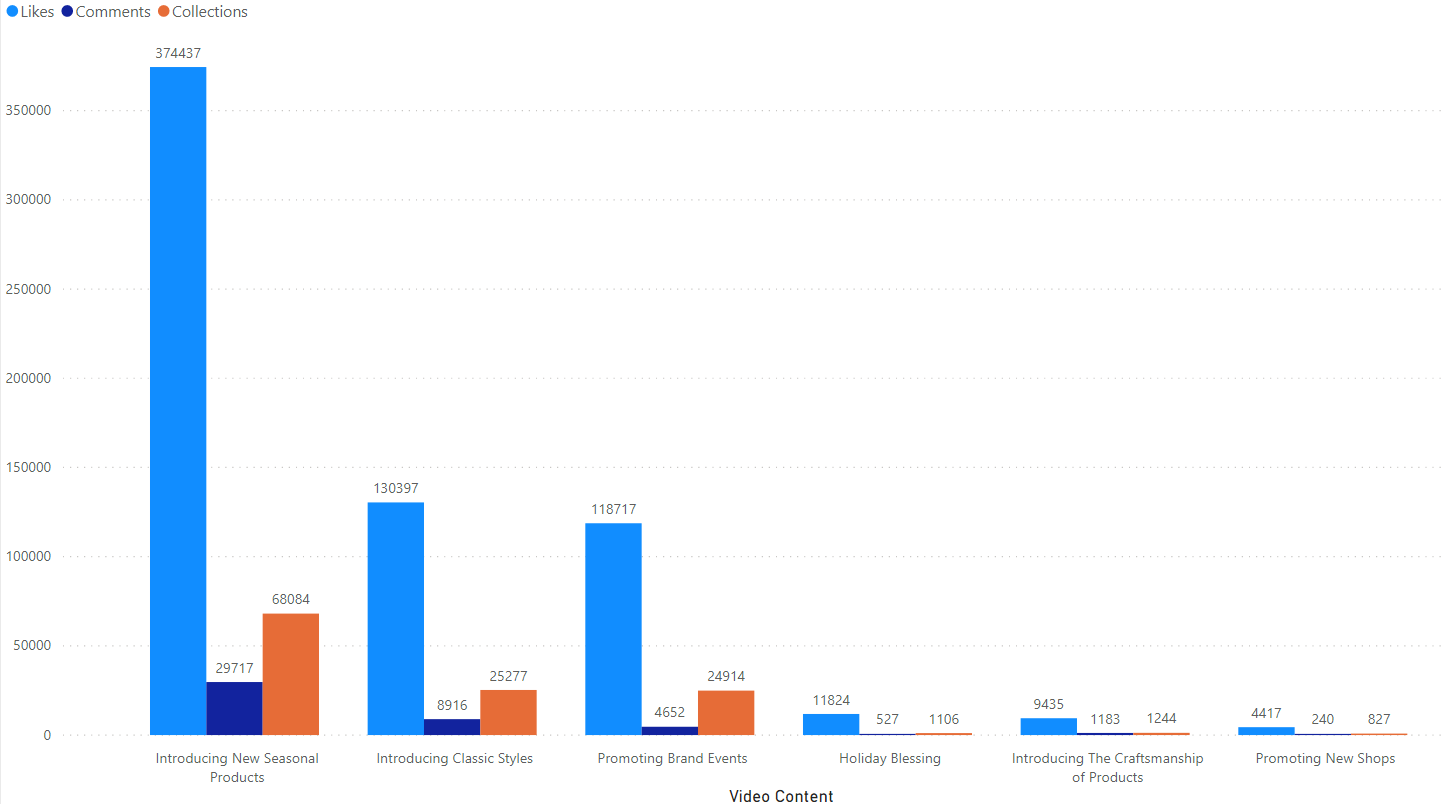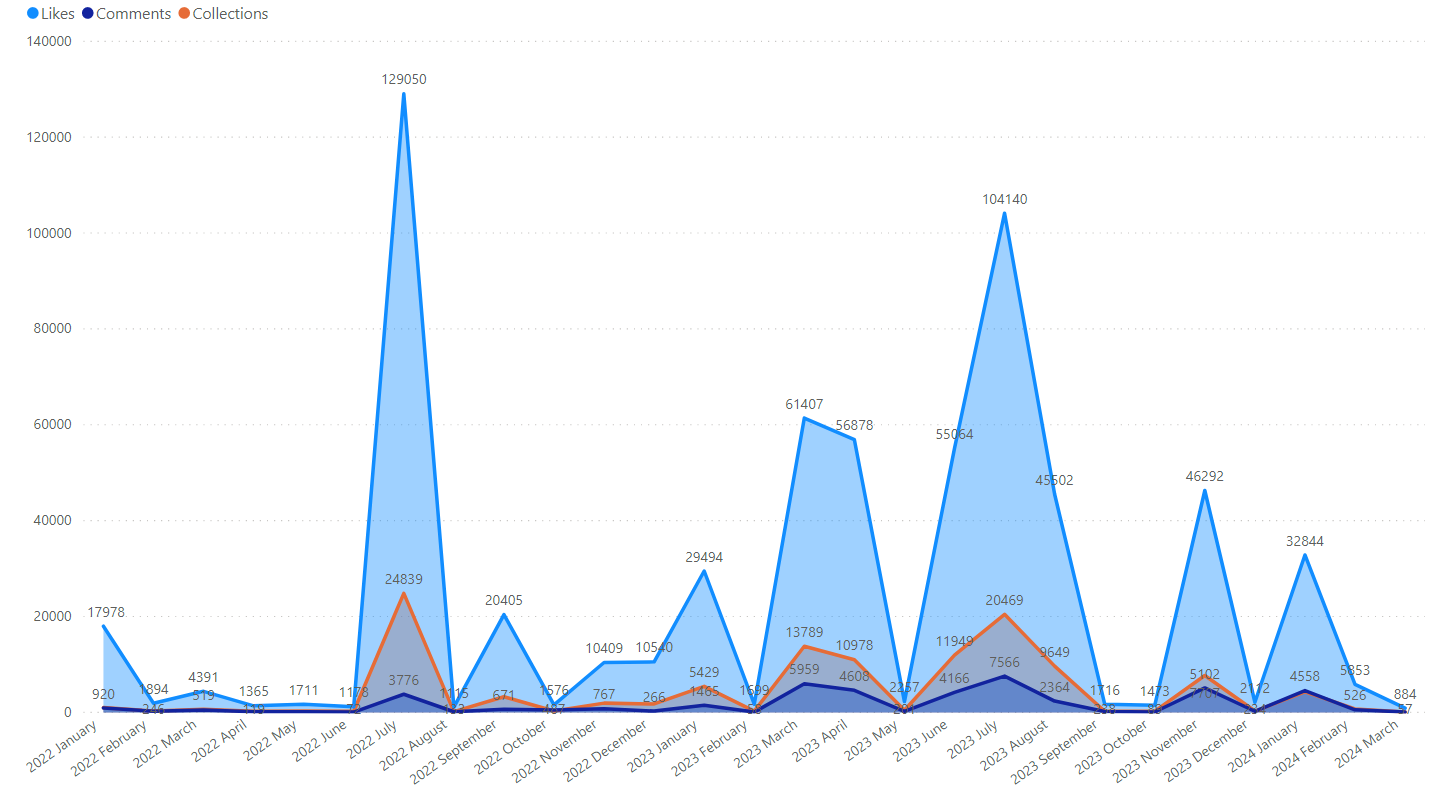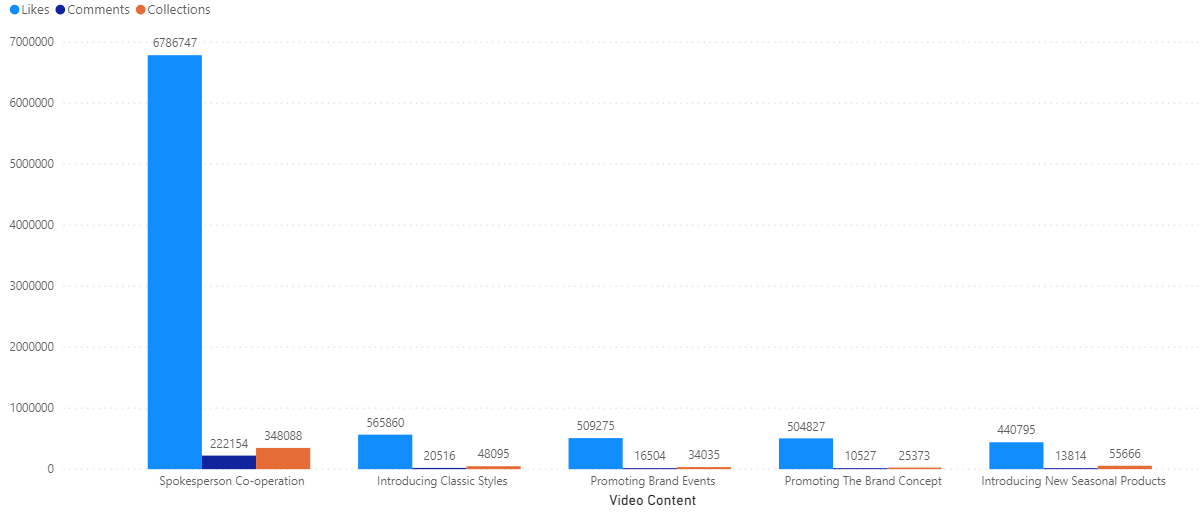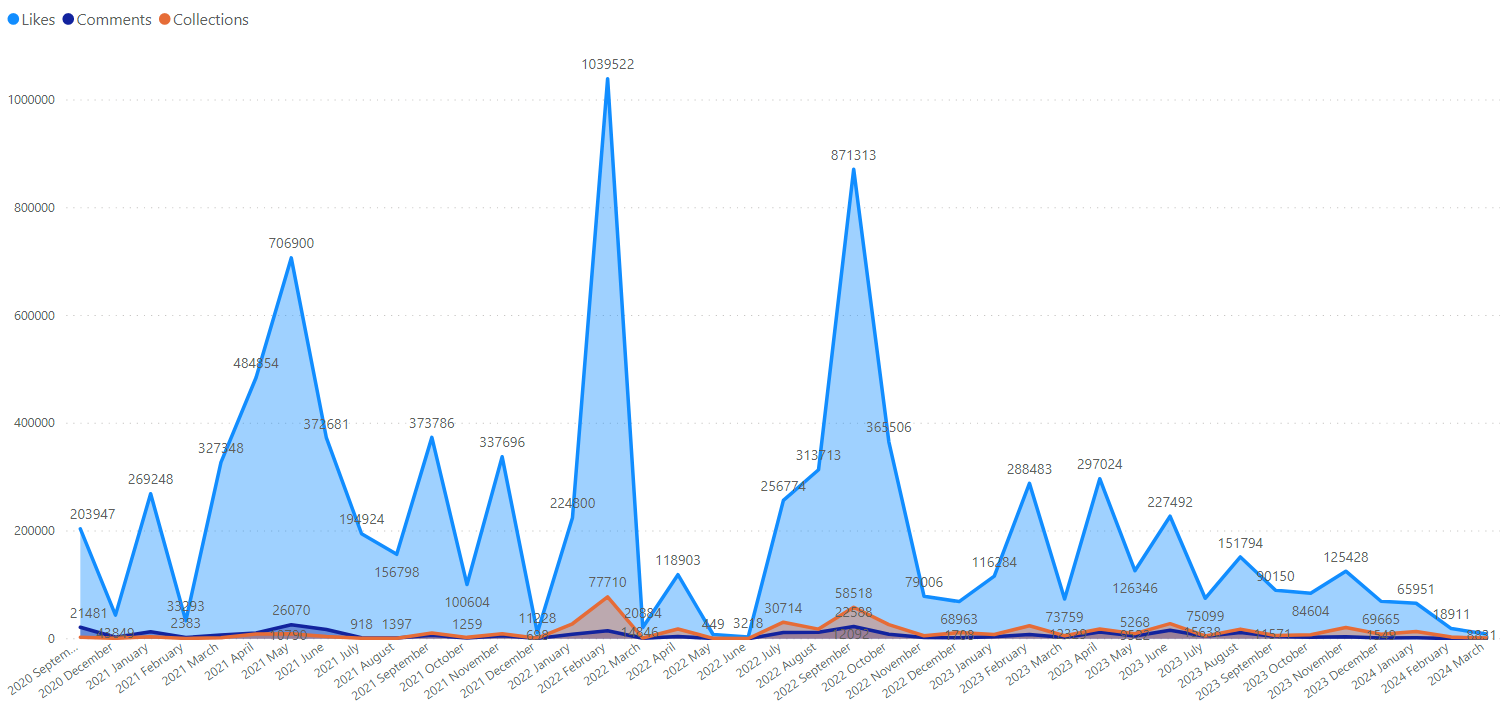1. Introduction
With the rapid development of mobile Internet technology, TikTok, as an emerging social media platform, has rapidly emerged as the focus of global users. TikTok has become an important platform for brand marketing because of its unique short video format, accurate algorithmic delivery, and highly interactive community. The luxury industry, as a representative of the pursuit of quality, uniqueness and high-end experience, has also carried out brand marketing on the ShakeYin platform in recent years. Currently, brand marketing on social media platforms is a diversified and personalised trend. By posting high-quality short video content, luxury brands show the unique charm of their products and attract the attention of target users. With the rapid development of the TikTok platform and the continuous expansion of the luxury market, how luxury brands conduct effective marketing in the TikTok platform has become a new research field.
This study aims to deeply analyse the marketing behaviours of luxury goods on TikTok, a social media platform, systematically sort out the diversified marketing tactics they adopt, and explore the influencing factors behind these tactics. Through in-depth analyses, it aims to reveal the core issues of how luxury goods build brand image, enhance user awareness, and promote sales conversion on TikTok, providing theoretical support and practical guidance for luxury brands to formulate more accurate and effective marketing strategies.
This study has certain significance to the community of practice. Firstly, the results of the study can increase the understanding of the marketing of luxury brands on social media platforms and provide academics with new knowledge about the marketing strategies of luxury brands on social media platforms. Second, the findings could provide practical guidance for luxury brands to help improve their marketing strategies on social media platforms to enhance brand influence and sales performance. In addition, the findings may also trigger further research to advance the study of brand marketing strategies on social media in the era of the digital economy.
The research method of this paper mainly adopts the combination of literature review, case study, and data analysis to conduct an in-depth study on the current situation, methods and development trends of the marketing of luxury brands in social media platforms. Firstly, through a literature review, relevant studies on brand marketing in social media platforms, marketing strategies of luxury brands, and marketing characteristics of TikTok platforms at home and abroad are systematically sorted out to provide theoretical support and research foundation for this study. Secondly, this study takes two representative luxury brands, Van Cleef & Arpels and Tiffany, as examples for in-depth case analysis. By collecting video data from the accounts of these two brands on the TikTok platform, including indicators such as the number of likes, comments, favourites, and video types, their marketing strategies, effects, and user interactions are analysed in detail. The case study in this paper not only helps to reveal the marketing characteristics and patterns of luxury brands on the TikTok platform, but also provides useful reference and inspiration for other brands. Through statistics, analyses and comparisons of the collected data, this study explores the relationship between the marketing effectiveness of luxury brands on the TikTok platform and user interactions, as well as the differences and advantages and disadvantages between the contents of different marketing strategies. The results of the data analysis provide strong empirical support for this study. Finally, this study explores the development trend and future outlook of luxury brands on the TikTok platform. With the continuous development and improvement of social media platforms such as TikTok, the marketing strategies of luxury brands will continue to be innovative and optimised. In the future, brands will pay more attention to user experience and data-driven marketing strategies to achieve more accurate target user positioning and more efficient marketing results.
2. Literature Review
With the popularity of the Internet and the rise of social media platforms, the ways and strategies of brand marketing have undergone profound changes. Especially on short video platforms such as TikTok, the form and content of brand marketing are diversified and personalised. In the era of digital economy, the organic combination of brand marketing and social media helps to break the information to reduce the search cost. In this paper, we analyse the papers related to the current situation and development of brand marketing in social media, and according to the content and research direction of the papers, we can extract the following aspects: the strategy of luxury brand marketing, social media marketing methods, and the impact of marketing on brand and consumer behaviour.
2.1. The Strategy of Luxury Brand Marketing
In the context of the rapid development of the digital economy, the luxury goods industry is undergoing unprecedented transformations. Notably, the marketing trends of luxury goods have shifted significantly under the influence of the "Internet +" era. Luxury brands are now placing greater emphasis on the Chinese market, leveraging high-profile influencers to capture the attention of young consumers. This shift is reflected in the brands' preference for collaborating with popular traffic stars instead of traditional, established actors. The younger generation, in particular, values interaction with brands, making social platforms like Weibo, WeChat, and TikTok key channels for information acquisition and communication. To cater to this trend, luxury brands have formulated interactive marketing strategies tailored to the tastes of the youth. High-profile influencers' activity on these platforms has sparked large-scale consumer buying behavior, driving the growth of the online luxury goods market [1]. Additionally, customized social marketing has emerged as a core strategy, focusing not only on offline efforts but also on expanding online presence through targeted advertising and content placement. By managing their customer relationships through digital means like mobile membership cards and electronic coupons, luxury brands aim to enhance customer satisfaction and loyalty [2]. In conclusion, the luxury goods industry is evolving to embrace digital marketing strategies that are more aligned with the preferences and behaviors of the younger generation, driving innovation and growth in the sector.
2.2. Social Media Marketing Methods
The crux of social media brand marketing lies in precise positioning, brand consistency, and technological innovation. On the TikTok platform, this strategy manifests as consumer-centered precision marketing, crafting a unique brand image, nurturing a professional operational team, and leveraging a robust technological innovation system [3]. By meticulously planning content, brands attract user attention, leverage the platform's algorithms for personalized recommendations, and enhance user engagement. Simultaneously, they shape a consistent and deeply ingrained brand image through integrated marketing communication.
To ensure the effective implementation of marketing strategies, enterprises need to cultivate a professional team with a new media marketing mindset and leverage technological innovations, such as TikTok's decentralized recommendation engine, to achieve precise scanning and tracking of consumers. This enhances the effectiveness of marketing activities and the efficiency of value creation. This strategic theory emphasizes consumer demand as the center, leveraging technological innovation and professional operations to achieve effective brand communication and sustainable development on social media platforms [4].
Furthermore, it's worth noting that social media platforms, such as TikTok, offer a dynamic and interactive environment that demands constant adaptation and innovation in marketing strategies. Brands need to stay vigilant in monitoring user behaviors, preferences, and trends to adjust their content and messaging accordingly [5]. Additionally, the integration of data analytics and user feedback loops can provide valuable insights for optimizing marketing efforts and enhancing brand engagement [6].
In conclusion, the core of social media brand marketing on platforms like TikTok lies in precise positioning, brand consistency, and technological innovation. By focusing on consumer needs, leveraging technological advancements, and cultivating a professional team with a new media marketing mindset, brands can effectively communicate their message, build a strong brand image, and achieve sustainable growth in the dynamic social media landscape [7].
2.3. The Impact of Marketing on Brand and Consumer Behaviour
In today's digital era, social media has emerged as a crucial platform for brands to interact with consumers. Consumers widely expect brands to maintain an active presence on social media, believing that there is no so-called "first-mover advantage" in this domain; that is, brands have the opportunity to succeed regardless of when they enter the social media space. For brands, social media is no longer merely a channel to reach consumers; it has transformed into a powerful tool that can shape brand image and enhance brand value. On social media, brands can attract consumers' attention and engage with them by posting interesting and trendy content, thus fostering deep emotional connections [8].
Consumers' preferences for brand content on social media have also shifted. They are no longer satisfied with simple advertising messages but instead prioritize content that is entertaining and interactive. Therefore, brands need to keep up with the latest trends and continuously innovate content formats to meet consumer demand. With the continuous development of digital technology and the increasing number of internet users, social media marketing faces new challenges and opportunities. Brands must leverage advanced digital technologies to create more attractive and interactive social media marketing campaigns, thereby effectively enhancing their brand image and achieving marketing objectives [8].
3. Cases and Data Analysis
Van Cleef & Arpels is part of the Richemont group and Tiffany & Co. is part of the LVMH group, both of which are leaders in the luxury vertical - jewellery - and the two groups to which they belong are also competitors. According to the FY2023 results report of the two groups, the overall growth rate of the luxury market has slowed down, but against this backdrop, LVMH's watch and jewellery division achieved a 7% year-on-year increase in operating profit to 2.162 billion euros for the full year, while Richemont's jewellery category represented by Van Cleef & Arpels is still the most robust. The two brands are particularly interesting to study as they are deeply rooted in social media platforms and focus on developing online business models, especially in terms of online sales. This study obtained a total of 746 video plays from both brands up to 28 March 2024 through the TikTok platform.
3.1. Van Cleef & Arpels
Van Cleef & Arpels is a French luxury brand that specialises in jewellery, watches and perfumes. For more than 100 years, the brand has been renowned worldwide for its unique creativity and exquisite fine jewellery craftsmanship.
Van Cleef & Arpels' TikTok videos focus on the history of the brand, its jewellery designs, its exhibitions and its product collections. Through the videos, Van Cleef & Arpels will show its audience the history and culture of the brand, emphasising the connection between its centuries-old family and a good marriage.
Van Cleef & Arpels officially announced in January 2022 that it had entered the TikTok platform, and in the past two years it has attracted 187,000 followers, posted 342 entries, and gained a total of 668,000 likes. Through analysis, it is found that Van Cleef & Arpels' content about seasonal new products has the best response, and the brand's account has the highest heat in winter, with an average of more than 500 likes per video (mainly concentrated in November-January), and the video with the highest number of likes to date is about seasonal new products, which has received a total of 87,142 likes.
Brand marketing strategies have a major impact on account heat:
Firstly, to increase brand awareness and exposure, the TikTok platform has a huge user base, and by posting carefully crafted video content, Van Cleef & Arpels is able to quickly reach potential customers and increase brand awareness and exposure. The dissemination speed and breadth of video content also far exceeds that of traditional advertising forms, and the amount of retweets for each entry is considerable, helping the brand gain wider recognition in a shorter period of time (figure 1).
Second, shaping brand image and values: Van Cleef & Arpels' video focuses on conveying the brand's history, culture and design concepts, and shapes the brand's high-end and exquisite image by showcasing the unique craftsmanship and exquisite details of jewellery. At the same time, the values of cherishing time, nature and love incorporated in the video content further deepen consumers' sense of identity and goodwill towards the brand (figure 2).
Thirdly, enhance interaction and communication with consumers: the TikTok platform is highly interactive and social, and Van Cleef & Arpels can establish a closer connection with consumers by posting video content and initiating topic challenges, which can trigger viewers' behaviour such as commenting, liking and sharing. Brands can also leverage the live streaming function of the TikTok platform to interact with consumers in real-time, answer questions and provide personalised services, further enhancing customer satisfaction and loyalty. Brands have also added a new product page on the TikTok homepage, which can fulfil consumers' purchase expectations in a timely manner (figure 3).

Figure 1: Video content of Van Cleef & Arpels.

Figure 2: Video data of Van Cleef & Arpels.

Figure 3: Video data Van Cleef & Arpels by time series.
3.2. Tiffany
Tiffany (Tiffany) is an American jewellery brand and a well-known place for socialites and elites to shop for diamonds. Tiffany's exclusive colour, Tiffany Blue, has always influenced consumers' first impression of the brand.
Tiffany's TikTok video content mainly focuses on its brand philosophy, classic styles, celebrity collaborations, etc. Based on its brand philosophy that "fine jewellery shouldn't just be stored in a safe, but worn and presented", Tiffany is constantly looking for appropriate marketing strategies in TikTok to meet the brand's growth needs (figure 4).
Tiffany opened its official account and released its first video in TikTok in September 2020. Up to now, Tiffany's official account has a total of 1,596,000 followers, 425 works released, 10,882,000 likes, and is ranked 27th in TikTok's luxury goods heat list, with a 10.2% increase from the previous period (2024.3.03-3.09). Combined with the data collected on videos released by Tiffany over the past four years, the analysis concludes that videos about celebrity cooperation content have the highest degree of heat, and that videos released within the summer and autumn seasons receive significantly more attention than those released in other seasons, with an average of more than 10,000 likes per video (mainly concentrated in June-October), and that the video content with the highest number of likes up to the present time has been celebrity cooperation, which has received a total of 453,588 likes.
The determining factors that influence the number of likes on a brand's official account include:
Firstly, content-audience fit understanding and pinpointing the target audience is the key to attracting attention. Analysing the 410 videos released by Tiffany, the videos about celebrity cooperation are released most frequently, and the top ten videos with the highest number of likes are all about brand spokespersons wearing products. Tiffany's video content meets the interests and needs of its target audience, thus attracting their attention and motivating their willingness to interact, which in turn increases the number of likes (figure 5).
Second, release strategy: appropriate release time, frequency and continuity will also have an impact on the attention of the video. Tiffany is able to accurately grasp the active time of users and publish content during this time period, while maintaining a publishing frequency of 3-5 days between time intervals, so it is more likely to attract users' attention (figure 6).
Third, interaction and socialisation: on the TikTok platform, interaction and socialisation between users is very important. Tiffany adds interactive elements to its videos, such as launching topics and asking users to participate, so as to encourage users to participate in comments and likes, thus increasing the attention and interaction rate. At the same time, Tiffany also added a new product purchase page on the TikTok homepage, so that users can go to the official website and get to know more about the products they want.

Figure 4: Video content of Tiffany.

Figure 5: Video data of Tiffany.

Figure 6: Video data of Tiffany by time series.
4. Conclusion
Comparison of the two brands found that Tiffany compared to Van Cleef & Arpels into the TikTok platform earlier, according to the current data Tiffany in the TikTok platform is significantly higher than the Van Cleef & Arpels heat, marketing results are significant. Analysing the video content of the two brands, it can be seen that Van Cleef & Arpels mainly advertises the brand history and product craftsmanship, while Tiffany is more inclined to make use of the celebrity spokesperson effect to attract the heat, according to the existing data, we speculate that the luxury brands release the content related to the celebrity cooperation on TikTok platform to attract the heat of the fans, and at the same time, with the more frequent interaction with the user strategy, it will enhance the fan sticking degree to expand the degree of brand publicity and influence. The study is limited in that it only focuses on the content of celebrity collaborations on TikTok.
However, the limitation of this study is that it only focuses on the head brands in the luxury jewellery industry, and the results of the study are targeted, so in the future, the research direction can continue to study different levels of brands on the basis of this study, so as to help the social media marketing strategy of the whole luxury goods field. To sum up, from the data, luxury brands focus on releasing targeted and attractive works in quarters with high user attention can deepen the brand impression of more users on the TikTok platform and realise the long-tail effect.
References
[1]. Giuseppe Colella, Cesare Amatulli and Maria Pilar Martinez-Ruiz(2019), "Social Media Marketing and Luxury Consumption: A Literature Review",International Journal of Marketing Studies,DOI: 10.5539/ijms.v11n4p30.
[2]. Elisa Arrigo,(2018) "Social media marketing in luxury brands: A systematic literature review and implications for management research", Management Research Review, https://doi.org/10.1108/MRR-04-2017-0134.
[3]. Cai, Li Rong. (2024). Brand marketing strategy of Jitterbit short video platform in the context of new media. Northern Economy and Trade, (02), 90-94..
[4]. Hongzhi Gao, Mary Tate, Hongxia Zhang, Shijiao Chen, and Bing Liang(2018), "Social Media Ties Strategy in International Branding: An Application of Resource-Based Theory ",American Marketing Association,doi:10.1509/jim.17.0014.
[5]. Fei, Xian Zheng, Jiang, Wen, & Wang, Hai Yan. Cold or warm: The matching effect between self-awareness in social media use and communication style of luxury advertising Online First. Foreign Economics & Management, 1-18.
[6]. Han, Hong Mei. (2021). Analysis of luxury goods marketing strategy under the background of ‘Internet +’. China Market, (30), 116-117.
[7]. He, Ai Zhong, Cai, Ling, & Gao, Jie. (2016). The Influence of Brand Owned Media Content Marketing on Consumer Brand Attitudes. Chinese Journal of Management, 13(10), 1534-1545.
[8]. Bruno Godey , Aikaterini Manthiou , Daniele Pederzoli , Joonas Rokka , Gaetano Aiello ,Raffaele Donvito and Rahul Singh,(2016)"Social media marketing efforts of luxury brands: Influence on brand equity and consumer behavior",Journal of Business Research, http://dx.doi.org/10.1016/j.jbusres.2016.04.181.
Cite this article
Sun,Z.;Zhang,J. (2024). Research on the Current Status, Approaches, and Development of Brand Marketing in Social Media Platforms: An Analysis of Luxury Brand Marketing on TikTok Platform. Lecture Notes in Education Psychology and Public Media,54,175-182.
Data availability
The datasets used and/or analyzed during the current study will be available from the authors upon reasonable request.
Disclaimer/Publisher's Note
The statements, opinions and data contained in all publications are solely those of the individual author(s) and contributor(s) and not of EWA Publishing and/or the editor(s). EWA Publishing and/or the editor(s) disclaim responsibility for any injury to people or property resulting from any ideas, methods, instructions or products referred to in the content.
About volume
Volume title: Proceedings of the 5th International Conference on Education Innovation and Philosophical Inquiries
© 2024 by the author(s). Licensee EWA Publishing, Oxford, UK. This article is an open access article distributed under the terms and
conditions of the Creative Commons Attribution (CC BY) license. Authors who
publish this series agree to the following terms:
1. Authors retain copyright and grant the series right of first publication with the work simultaneously licensed under a Creative Commons
Attribution License that allows others to share the work with an acknowledgment of the work's authorship and initial publication in this
series.
2. Authors are able to enter into separate, additional contractual arrangements for the non-exclusive distribution of the series's published
version of the work (e.g., post it to an institutional repository or publish it in a book), with an acknowledgment of its initial
publication in this series.
3. Authors are permitted and encouraged to post their work online (e.g., in institutional repositories or on their website) prior to and
during the submission process, as it can lead to productive exchanges, as well as earlier and greater citation of published work (See
Open access policy for details).
References
[1]. Giuseppe Colella, Cesare Amatulli and Maria Pilar Martinez-Ruiz(2019), "Social Media Marketing and Luxury Consumption: A Literature Review",International Journal of Marketing Studies,DOI: 10.5539/ijms.v11n4p30.
[2]. Elisa Arrigo,(2018) "Social media marketing in luxury brands: A systematic literature review and implications for management research", Management Research Review, https://doi.org/10.1108/MRR-04-2017-0134.
[3]. Cai, Li Rong. (2024). Brand marketing strategy of Jitterbit short video platform in the context of new media. Northern Economy and Trade, (02), 90-94..
[4]. Hongzhi Gao, Mary Tate, Hongxia Zhang, Shijiao Chen, and Bing Liang(2018), "Social Media Ties Strategy in International Branding: An Application of Resource-Based Theory ",American Marketing Association,doi:10.1509/jim.17.0014.
[5]. Fei, Xian Zheng, Jiang, Wen, & Wang, Hai Yan. Cold or warm: The matching effect between self-awareness in social media use and communication style of luxury advertising Online First. Foreign Economics & Management, 1-18.
[6]. Han, Hong Mei. (2021). Analysis of luxury goods marketing strategy under the background of ‘Internet +’. China Market, (30), 116-117.
[7]. He, Ai Zhong, Cai, Ling, & Gao, Jie. (2016). The Influence of Brand Owned Media Content Marketing on Consumer Brand Attitudes. Chinese Journal of Management, 13(10), 1534-1545.
[8]. Bruno Godey , Aikaterini Manthiou , Daniele Pederzoli , Joonas Rokka , Gaetano Aiello ,Raffaele Donvito and Rahul Singh,(2016)"Social media marketing efforts of luxury brands: Influence on brand equity and consumer behavior",Journal of Business Research, http://dx.doi.org/10.1016/j.jbusres.2016.04.181.









